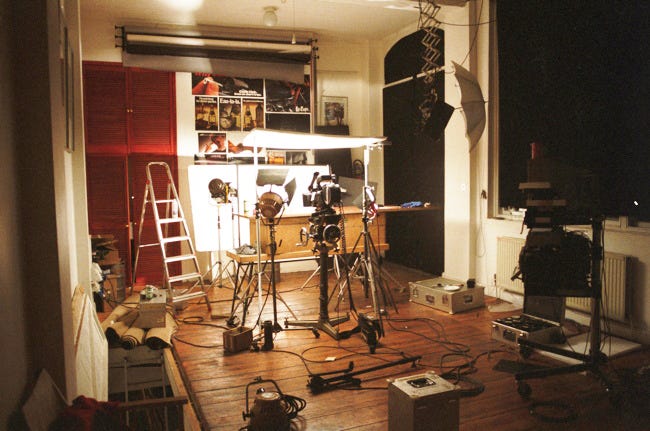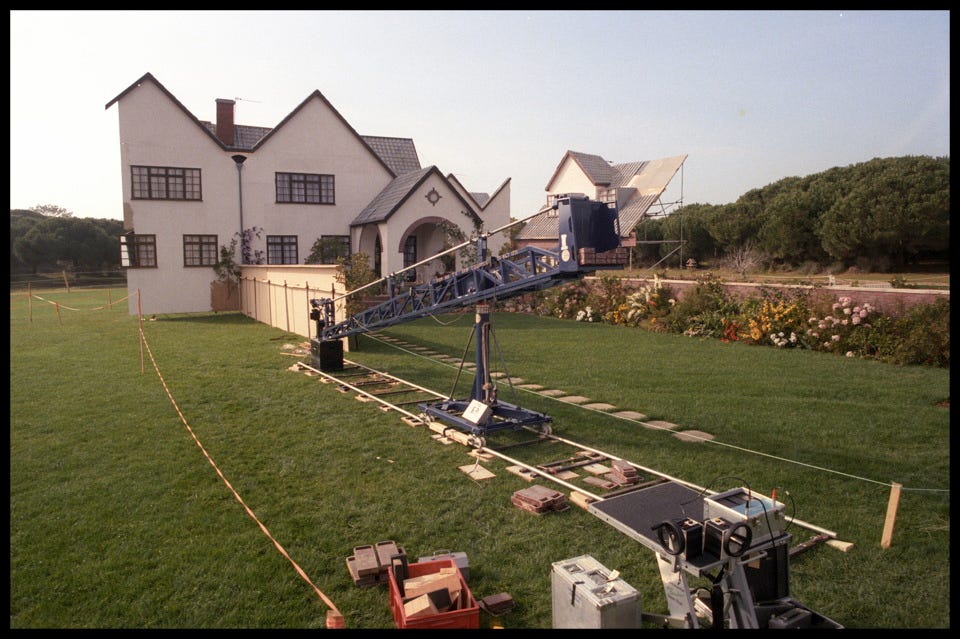The Great 1985 Toblerone Incident
Self-induced Toblerone Aversion Therapy and commercials in the 80s

Don't get me wrong about Toblerone. It's a fine confectionary, even if a little oddly shaped, but too much of anything can put you off, and I've really not eaten much since this dark incident in 1985, when ... well - let's start at the beginning.
I'd been a runner and Camera Trainee for three years when I started at Beechurst in 1984, a company that made commercials. Back then the ACTT union was super powerful, and was a closed shop (illegal now, but all the rage then) - you couldn't work without a union card, but you couldn't get a union card without having a job. There were a few ways in, though, and being a Camera Trainee (restricted to grade and company Rule 9c) at a Film Production Company was one of them. I wanted to stay in movies, but the all important Union Card was a big deal in those days - and amongst runners and trainees a perennial topic of conversation. Other routes in were working for a Camera rental company, or through the laboratories.
So I found myself at Beechurst, and was there for three years. I was generally okay at my job but an occasional idiot, to be honest, and in retrospect Peter Levelle (director) and Trevor Evans (producer) treated me more fairly than I sometimes deserved - I think you kind of do that when employing people in their early twenties, overlook their twatty moments as other people did when you were first employed yourself.

In any event, Beechurst used to shoot at least once every couple of weeks so it was busy busy - sometimes location, sometimes studio, but all good stuff and with proper budgets, so we had decent sets built and foreign locations - once to The British Virgin Islands for Ringos - 'No ring goes like a ringo goes' where in an off moment Trevor and I went and videoed the progress on Branson's half-constructed house on Necker Island, a good piece of PR that had us shoot Virgin Airways commercials with Branson himself the following year. Greece for Croft Original was a good gig, too - all on a 1920's Motor Yacht for transport and location, and with star of the screen and stage Michael Dennison (who will feature later in A Galaxy of Stars). We did the Vauxhall Astra GT Launch, numerous Condor Tobacco spots, dropped a Volkswagen from the rafters and even had a Soviet Submarine surfacing in the Thames for Cockburn’s Port.
We also did quite a few commercials with a company called Frog Films in Paris, so in addition to my duties as clapper/loader and camera maintenance, I also used to drive the company's Renault Master over to Paris to shoot commercials with Peter directing, and sometimes we shot commercials for the French over here. Driving to Paris on a regular basis was great fun - especially as we would take two days to do it, claiming 'that's how long it took' but actually went sightseeing at the Somme and other battlefields and then legged it down to Paris at the last minute.
Driving through Paris during the rush hour to get to a location on time required a driving technique which was basically 'put your foot down and grip the steering wheel with a look of steely determination, take no prisoners'. It worked. On one occasion we shut down the traffic around the Arc de Triomphe for a Hertz commercial featuring The Two Ronnies, with Mr B supposedly driving the wrong way round. We shot early Sunday morning, and the authorities shut down the traffic for an hour so we could get the shots we needed. I'm thinking it must have been pricey, even in those days - plus we needed about forty stunt cars and drivers to play the ‘normal’ traffic. This is that Commercial:
Anyhoo:
Toblerone was for a French Agency, and when you shoot a commercial there is always a 'pack shot', which as the name suggests, shows the product off in the best manner possible, and it is usually done at the end of the shoot, and takes a traditionally long time, as the delicate lighting set up could take hours to finesse - especially as the client and agency all liked to get involved, and it was the one area where their on-set participation is invited. Can be boring. In fact, my idea of hell would be stuck on a freezing stage somewhere on a Friday, trying to shoot a packshot that the client is never happy about, and waiting for a supper break or wrap that never arrived. For all eternity.
Old commercials joke: How many creatives (The term for the Art Director and Copywriter advertising team) does it take to change a lightbulb? Answer: 'I don't know, what do you think, George? '
The packshot is also where the propman comes into his own, and why props on a film differ to those doing commercials, as commercials props usually arrive with boxes and boxes of paraphenalia to enable them to fine tune a pack of whatever it is we're selling. Many commercials propmen actually had small trailers that were mobile workshops, and used all sorts of chemicals and gizmos to get the perfect head on beer or generate smoke or put condensation on a lager class - and they could pretty much mock up anything, given the time. A very unusual skillset. Pouring milk was generally white emulsion paint, an ice cream scoop instant mashed potato with food colouring.
But don't forget we're talking about the pre digital age here. When I left the industry in 2000 Computer Generated Imagery was picking up in popularity - the now hokey (by modern standards) CGI stuff you saw in Terminator 2 in 1991 was serious cutting edge, as was Jurassic Park in 1993 and Toy Story in 1995. It was there, but it was super expensive and time consuming; commercials only really caught up big time with 'surfers with white horses' for Guinness in 1999.
CGI was coming in big time as I was going out, but back in the eighties CGI was non-existent; if you wanted to morph a lemon into a frog (yes, really, we did this) then a model maker built 35 separate models representing a tiny change each and you animated them one frame at a time, each model having registration pegs on the underside to ensure they were in the correct place. I worked on commercials with hanging miniatures, glass paintings, front and back projection, and even used mirrors to insert flames into a shot. What you saw through the camera was very often what you ended up with. The all too familiar and much used phrase: 'we'll fix it in post' had not yet been invented.

Back to the packshot: If the pack to be filmed was printed especially then the propman would build them up, but more usually the product would arrive in bulk to be rummaged through for the 'hero' pack. The pack had to be perfect as it would fill the screen, so because of manufacturing errors and transport damage you might sort though hundreds before finding a perfect one (Commercial photographer Lester Bookbinder once reportedly sliced in half every onion from two full sacks before finding a perfect one) - and if you needed packs with special action, such as the tearing off of a wrapper to reveal the choccy beneath or a bite shot, then you'd need repeats of these, too. The point is, product was not generally twenty packs or so, but a palletload - especially if they were French packs that we couldn't get in London.
When I said 'Pallet load' I'm not being hyperbolic - it really was a pallet load. I don't recall the propman - maybe the wonderful Harry Bearpark, a poker-faced comic affectionately known as 'H' - but he went though several boxes to find the heroes and the repeats for the biting shot, but once the commercial was over there was still quite a lot of product left - actually, there was tons left - all of which was transported back to the office where it sat in the basement, as it was, technically at least, the property of the client. Myself and Graham, the runner, eyed the packs greedily and ate most of the half open packs almost immediately, but didn't eat the open ones. Yet.
I suppose the free-for-all began with Peter the director who initially (and legitimately) took a few boxes for friends and family. Seeing this, Trevor the producer also took some - and so on, down through the ranks, so the pile of Toblerone rapidly diminished in size. Seeing all this, of course, convinced me and Graham that we could scoff as much as we wanted and did, eating what remained in a time scale that would seem, in retrospect, to be almost obscenely short.

But that's not really the end of the story, because two months down the line there was a reshoot and the French client said they obviously did not need to send us more product as we could use the huge quantity already sent - and, of course, the manner in which it was distributed meant that no-one really knew it had all gone. After all, when Peter took some there was tons left so he remembered a large pile, and when Trevor took some - you see the problem. No-one knew they'd all been eaten because everyone important remembers seeing a vast pile of packs remaining. But there were actually none left - not a single bar. The company had eaten the lot. And we got to the eve of the new shoot and Graham and I were asked by Trevor to 'throw the remaining packs on to the truck for the reshoot tomorrow'.
I looked at Graham, Graham looked back at me, Trevor looked at both of us, twigged what had happened and said: 'You greedy fuckers. You’ve fatnecked the lot, haven’t you?' and it was reported back to Peter that we'd eaten nearly a ton of Toblerone between us, as interestingly, all the other members of staff who'd been liberating the yummy comestible failed to mention that they may have had a hand in it too.
So we had to go upstairs and stand in front of Peter’s desk and we took our bollocking with good grace and without poitning the finger at anyone else, and neither of us were fired. But there was, presumably, an embarrassing phone call from production to France asking for more product in which we were heavily implicated, but there was no harm done. Except for me, and my aversion to Toblerone - which probably serves me right. I’m more into Lindt these days, but always show due restraint. Sort of.




Thank you for this – it's genuinely interesting to get the glimpse of live-action advert production. I've only done a couple of animated ones, for which one sadly does not get any consumable samples. All of the executive indecision, none of the perks!
This also explains the knowledgeable inclusion of low-poly CGI as a plot device – I've been wondering about that for 20 years!
... With triangular honey from triangular bees,
and triangular almonds from triangular trees...
😀